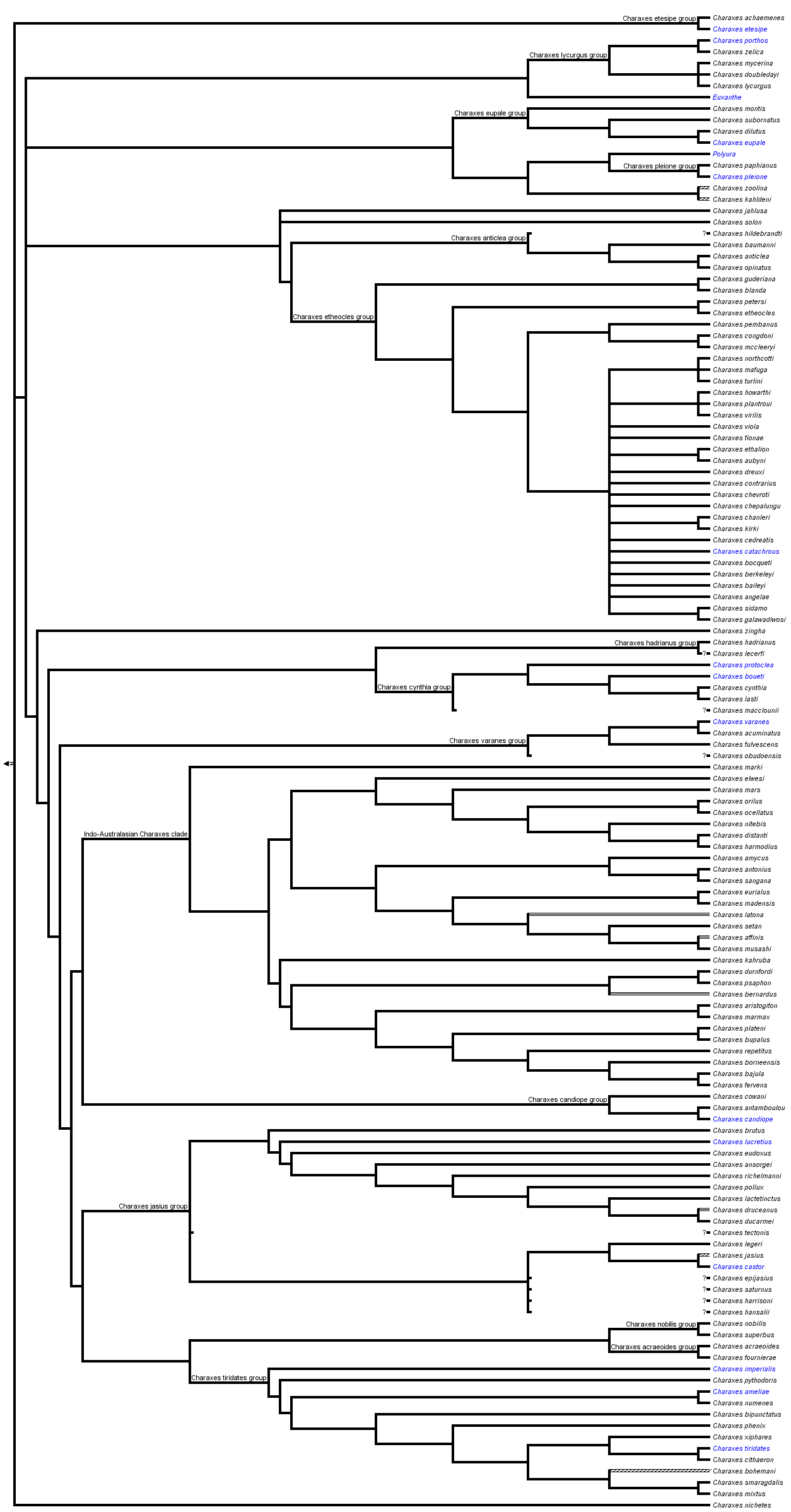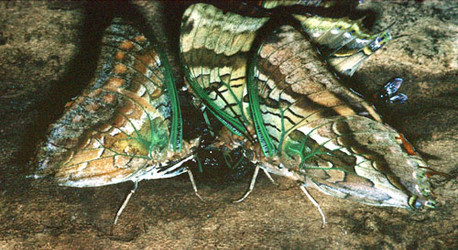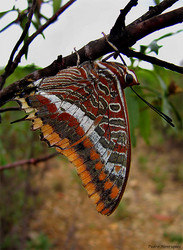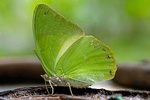Charaxes
Andrew V. Z. Brower


This tree diagram shows the relationships between several groups of organisms.
The root of the current tree connects the organisms featured in this tree to their containing group and the rest of the Tree of Life. The basal branching point in the tree represents the ancestor of the other groups in the tree. This ancestor diversified over time into several descendent subgroups, which are represented as internal nodes and terminal taxa to the right.

You can click on the root to travel down the Tree of Life all the way to the root of all Life, and you can click on the names of descendent subgroups to travel up the Tree of Life all the way to individual species.
For more information on ToL tree formatting, please see Interpreting the Tree or Classification. To learn more about phylogenetic trees, please visit our Phylogenetic Biology pages.
close boxIntroduction
Big, beautiful Charaxes butterflies - the most diverse genus in Africa? Or maybe the most oversplit. Ackery et al. (1995) state, "No group of African butterflies arouses stronger emotions than Charaxes." Gaining an understanding of their phylogenetic relationships will add a new chapter to their convoluted literature.
Most of the species above are Afrotropical taxa (Charaxes jasius extends to southern Europe). The clade C. marki - C. fervens are the ones distributed from Indomalaya, the Indonesian archipelago to New Guinea (in addition to C. solon).
Discussion of Phylogenetic Relationships
The tree displayed is based on information from several sources and does not represent a result of a single phylogenetic analysis. The backbone of the tree and the hypothesis that Polyura and Euxanthe are nested within a paraphyletic Charaxes is based on the molecular analysis of Aduse-Poku et al. (2009). Phylogenetic relationships of the Indo-Australasian clade have been examined by Müller et al. (2010), also based on DNA sequences, and that clade is inserted at its putative position based on partially-overlapping samples in these two studies. Several of the more widespread species appear to be paraphyletic, including C. bernardus, C. latona and C. affinis.Members of Larsen's (2005) putative species groups for west African taxa not sampled in the above studies are tentatively placed with their relatives. A long list of extralimital members of these groups is included on the parent of this page, and awaits a phylogenetic analysis.
References
Ackery PR, Smith CR, and Vane-Wright RI eds. 1995. Carcasson's African butterflies. Canberra: CSIRO.
Aduse-Poku, K., Vingerhoedt, E.,Wahlberg, N. 2009. Out-of-Africa again: A phylogenetic hypothesis of the genus Charaxes (Lepidoptera: Nymphalidae) based on 5 gene regions. Mol. Phylogenet. Evol. 53, 463-478.
Corbet AS, Pendlebury HM, and Eliot JN. 1992. The butterflies of the Malay Peninsula. Malayan Nature Society, Kuala Lumpur.
Cowan CF. 1968. Annotationes Rhopalocerologicae. Clunbury Press, Berkhamsted, Herts.
Larsen, T.B. 1991. The butterflies of Kenya and their natural history. Oxford University Press, Oxford, U. K.
Larsen, T. B. 2005 Butterflies of West Africa. Stenstrup, Denmark: Apollo Books.
Müller, C.J., Wahlberg, N.,Beheregaray, L.B. 2010. 'After Africa': the evolutionary history and systematics of the genus Charaxes Ochsenheimer (Lepidoptera: Nymphalidaae) in the Indo-Pacific region. Biol. J. Linn. Soc. 100: 457-481.
Parsons M. 1999. The butterflies of Papua New Guinea: their systematics and biology. Academic Press, San Diego.
Vane-Wright RI, and de Jong R. 2003. The butterflies of Sulawesi: annotated checklist for a critical island fauna. Zoologische Verhandelingen 343: 1-267.
Title Illustrations

| Scientific Name | Charaxes jasius |
|---|---|
| Location | Corcino, Aljezur, Portugal |
| Specimen Condition | Live Specimen |
| Source | Charaxes jasius |
| Source Collection | Flickr |
| Image Use |
 This media file is licensed under the Creative Commons Attribution-NonCommercial-NoDerivs License - Version 2.0. This media file is licensed under the Creative Commons Attribution-NonCommercial-NoDerivs License - Version 2.0.
|
| Copyright | © 2007 Pedro Henriques |
| Scientific Name | Charaxes eupale |
|---|---|
| Location | Nigeria: Port Harcourt |
| Specimen Condition | Live Specimen |
| Identified By | Dirk Motshagen |
| Behavior | feeding on bananas |
| Life Cycle Stage | adult |
| View | ventral |
| Copyright | © 2009 Dirk Motshagen |
About This Page

Middle Tennessee State University, Murfreesboro, Tennessee, USA
Correspondence regarding this page should be directed to Andrew V. Z. Brower at
Page copyright © 2012
 Page: Tree of Life
Charaxes .
Authored by
Andrew V. Z. Brower.
The TEXT of this page is licensed under the
Creative Commons Attribution License - Version 3.0. Note that images and other media
featured on this page are each governed by their own license, and they may or may not be available
for reuse. Click on an image or a media link to access the media data window, which provides the
relevant licensing information. For the general terms and conditions of ToL material reuse and
redistribution, please see the Tree of Life Copyright
Policies.
Page: Tree of Life
Charaxes .
Authored by
Andrew V. Z. Brower.
The TEXT of this page is licensed under the
Creative Commons Attribution License - Version 3.0. Note that images and other media
featured on this page are each governed by their own license, and they may or may not be available
for reuse. Click on an image or a media link to access the media data window, which provides the
relevant licensing information. For the general terms and conditions of ToL material reuse and
redistribution, please see the Tree of Life Copyright
Policies.
- First online 05 November 2006
- Content changed 12 March 2012
Citing this page:
Brower, Andrew V. Z. 2012. Charaxes . Version 12 March 2012 (under construction). http://tolweb.org/Charaxes/70521/2012.03.12 in The Tree of Life Web Project, http://tolweb.org/











 Go to quick links
Go to quick search
Go to navigation for this section of the ToL site
Go to detailed links for the ToL site
Go to quick links
Go to quick search
Go to navigation for this section of the ToL site
Go to detailed links for the ToL site